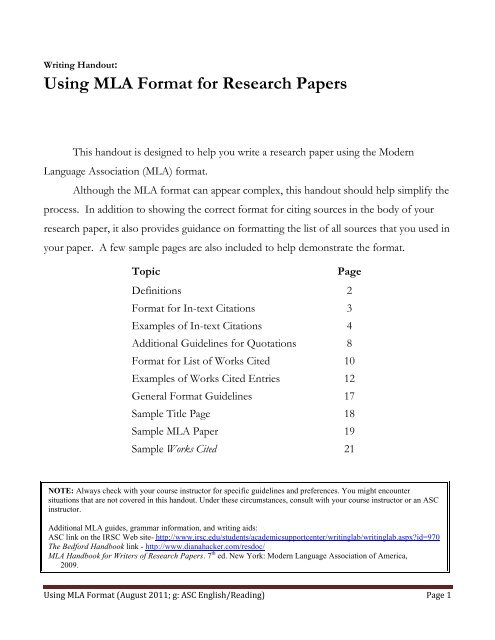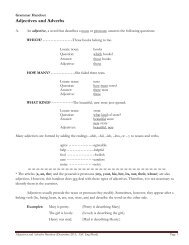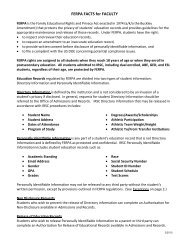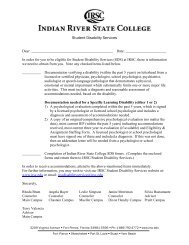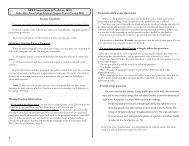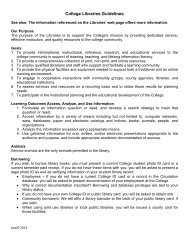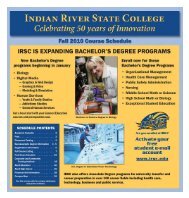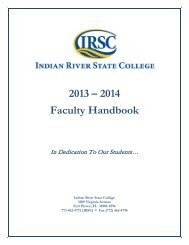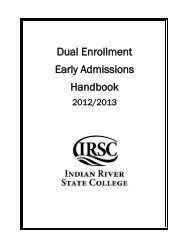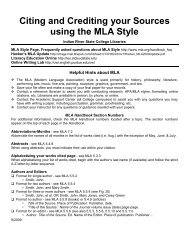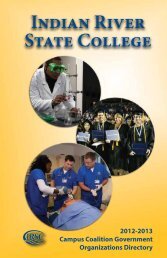Using MLA Format for Research Papers
Using MLA Format for Research Papers
Using MLA Format for Research Papers
Create successful ePaper yourself
Turn your PDF publications into a flip-book with our unique Google optimized e-Paper software.
Writing Handout:<br />
<strong>Using</strong> <strong>MLA</strong> <strong>Format</strong> <strong>for</strong> <strong>Research</strong> <strong>Papers</strong><br />
This handout is designed to help you write a research paper using the Modern<br />
Language Association (<strong>MLA</strong>) <strong>for</strong>mat.<br />
Although the <strong>MLA</strong> <strong>for</strong>mat can appear complex, this handout should help simplify the<br />
process. In addition to showing the correct <strong>for</strong>mat <strong>for</strong> citing sources in the body of your<br />
research paper, it also provides guidance on <strong>for</strong>matting the list of all sources that you used in<br />
your paper. A few sample pages are also included to help demonstrate the <strong>for</strong>mat.<br />
Topic<br />
Page<br />
Definitions<br />
2<br />
<strong>Format</strong> <strong>for</strong> In-text Citations 33<br />
Examples of In-text Citations 44<br />
Additional Guidelines <strong>for</strong> Quotations 8<br />
<strong>Format</strong> <strong>for</strong> List of Works Cited<br />
10<br />
Examples of Works Cited Entries<br />
12<br />
General <strong>Format</strong> Guidelines 17 17<br />
Sample Title Page 18 18<br />
Sample <strong>MLA</strong> Paper<br />
19<br />
Sample Works Cited<br />
21<br />
NOTE: Always check with your course instructor <strong>for</strong> specific guidelines and preferences. You might encounter<br />
situations that are not covered in this handout. Under these circumstances, consult with your course instructor or an ASC<br />
instructor.<br />
Additional <strong>MLA</strong> guides, grammar in<strong>for</strong>mation, and writing aids:<br />
ASC link on the IRSC Web site- http://www.irsc.edu/students/academicsupportcenter/writinglab/writinglab.aspx?id=970<br />
The Bed<strong>for</strong>d Handbook link - http://www.dianahacker.com/resdoc/<br />
<strong>MLA</strong> Handbook <strong>for</strong> Writers of <strong>Research</strong> <strong>Papers</strong>. 7 th ed. New York: Modern Language Association of America,<br />
2009.<br />
<strong>Using</strong> <strong>MLA</strong> <strong>Format</strong> (August 2011; g: ASC English/Reading) Page 1
Definitions<br />
Common knowledge — Common knowledge is in<strong>for</strong>mation that can easily be located in any<br />
number of reference sources or that is commonly known. Common knowledge does not need to be<br />
cited.<br />
Direct quotation — When you use the author’s exact words, you are quoting. A quotation must be<br />
enclosed in quotation marks.<br />
In-text citation — When you quote, paraphrase, or summarize from a source, you must include an<br />
in-text citation which provides brief in<strong>for</strong>mation about your source. A typical in-text citation<br />
includes the author’s last name and a reference marker (e.g., page number). In-text citations are<br />
written either as a parenthetical reference or as a signal phrase. (See page 3 <strong>for</strong> a further explanation.)<br />
<strong>MLA</strong> (Modern Language Association) style — The <strong>MLA</strong> style was developed to provide uni<strong>for</strong>m rules<br />
<strong>for</strong> documenting quotations, paraphrases, summaries, and lists of sources used to write a research paper.<br />
Paraphrase — When you restate the author’s ideas in your own words, you are paraphrasing. A paraphrase<br />
includes most of the details in roughly the same number of words as in the original version.<br />
Plagiarism — When you use another’s in<strong>for</strong>mation or ideas without indicating the source, you are stealing.<br />
This offense is very serious and can result in mandatory withdrawal from the course. To prevent<br />
plagiarizing, you must cite sources when you quote, paraphrase, or summarize from your sources.<br />
Summary — When you restate the main points of an author’s ideas (not all of the details) in a fewer<br />
number of words than the longer, original version, you are summarizing.<br />
Works Cited — The last page of your research paper is your Works Cited page and includes<br />
complete publishing in<strong>for</strong>mation <strong>for</strong> each of the sources cited in your paper. The sources are listed<br />
alphabetically.<br />
<strong>Using</strong> <strong>MLA</strong> <strong>Format</strong> (August 2011; g: ASC English/Reading) Page 2
<strong>Format</strong> <strong>for</strong> In-text Citations (6.1-6.3)<br />
In the written body of your paper, you must give credit whenever you quote or use another’s words,<br />
ideas, or thoughts. You give credit by using in-text citations that typically consist of the author’s last name<br />
(or the title of the source if the author is unknown) and a reference marker (e.g., page number). When a<br />
source lacks page numbers but has numbered paragraphs or sections, use the abbreviation “par.” or “sec.”<br />
If there are no reference markers, cite only the author’s name. In-text citations are written either as a signal<br />
phrase or parenthetical reference:<br />
Signal phrase<br />
A signal phrase includes the author’s name followed by an appropriate verb (such as asserts, claims,<br />
declares, defines, illustrates, notes, observes, reports, responds, suggests, or writes) which introduce the cited<br />
material. The reference marker <strong>for</strong> the cited material is placed in parentheses at the end of the sentence<br />
containing the quotation, paraphrase, or summary, followed by a period after the parentheses.<br />
Examples<br />
Signal phrase in a quotation.<br />
Czeisler reports, "Bright light produces a clear resetting of the subject's circadian rhythms, yet it is<br />
too early to know why this happens" (137).<br />
Signal phrase in a paraphrase or partial quote.<br />
Czeisler reports that bright light affects one's "circadian rhythms" although the explanation is not yet<br />
known (137).<br />
Signal phrase in a summary<br />
Czeisler finds that the proper timing of bright lights causes a longer period of alertness and clearer<br />
thoughts (137).<br />
Parenthetical reference<br />
In a parenthetical reference, the author’s name (or title of the source if the author is unknown) and<br />
reference marker (e.g., page number) are placed within parentheses at the end of the sentence containing the<br />
cited material. The period ending the sentence is placed after the parentheses.<br />
Examples<br />
Parenthetical reference in a summary.<br />
Other researchers confirm that bright light produces an actual resetting of the circadian rhythms<br />
(Rosenthal 147).<br />
<strong>Using</strong> <strong>MLA</strong> <strong>Format</strong> (August 2011; g: ASC English/Reading) Page 3
Parenthetical reference in a quotation<br />
Circadian rhythms are “[biological] processes that occur repeatedly on approximately a twenty-four<br />
hour cycle” (Feldman 125).<br />
Notes:<br />
1. When you cite a source more than once in a paragraph and no other intervening source has been<br />
cited, you need only provide a parenthetical reference on the last citation.<br />
2. When an entire paragraph is based on a single source, you may introduce the source (author) at the<br />
beginning of the paragraph using a signal phrase and then insert reference markers after each<br />
borrowing.<br />
Examples of In-text Citations<br />
If additional guidance is needed, reference to the applicable section of the <strong>MLA</strong> Handbook <strong>for</strong> Writers of<br />
<strong>Research</strong> <strong>Papers</strong> is included (in parentheses) <strong>for</strong> each example.<br />
A Work with One Author (6.2-6.3)<br />
Signal phrase<br />
In fact, Mapes believes that the accident at the Three Mile Island nuclear power plant happened<br />
because engineers ignored a series of warning signals (15).<br />
Parenthetical reference<br />
The accident at the Three Mile Island nuclear power plant happened at 4:00 a.m., and the Chernobyl<br />
reactor exploded at 1:23 a.m. (Mapes 15).<br />
A Work with Two or Three Authors (6.2-6.3)<br />
Signal phrase<br />
List all authors in the signal phrase or parentheses each time you cite the source.<br />
(125).<br />
Worchel and Shebilske report that a person's biological clock is internally set at twenty-four hours<br />
Parenthetical reference<br />
A person's biological clock is internally set at twenty-four hours (Worchel and Shebilske 125).<br />
<strong>Using</strong> <strong>MLA</strong> <strong>Format</strong> (August 2011; g: ASC English/Reading) Page 4
A Work with Four or More Authors (6.2)<br />
When the work has more than three authors, follow the <strong>for</strong>m you use in the Works Cited section of<br />
your paper; i.e., either list the first author's name followed by et al. (Latin <strong>for</strong> “and others”) or give all the last<br />
names.<br />
Signal phrase<br />
Czeisler et al. find similar results in monkeys (155).<br />
Parenthetical reference<br />
Similar results have been found in monkeys (Czeisler et al. 155).<br />
Similar results have been found in monkeys (Czeisler, Johnson, Duffy, Brown, Ronda, and<br />
Kronauer 155).<br />
Unknown Author (6.4.4)<br />
If the author is not given, either use the complete title in the signal phrase or use the full title (if<br />
brief) or a shortened <strong>for</strong>m of the title in parentheses.<br />
Complete title in the signal phrase<br />
The article "Are You a Day or Night Person?" states that the pineal gland, which releases melatonin<br />
at night, regulates the biological clock (14).<br />
Partial title in the parenthetical reference<br />
The pineal gland, which regulates melatonin at night, regulates the biological clock ("Are You" 14).<br />
Corporate Author (6.4.5)<br />
For names of groups that serve as authors (e.g., corporations, associations), use the name of the<br />
corporate author in the signal phrase or the parenthetical reference. If you give the name in the<br />
parenthetical reference, you may abbreviate it.<br />
Signal phrase<br />
The National Institute of Mental Health is studying the effect that altering circadian rhythms has on<br />
the memory (91).<br />
Parenthetical reference<br />
Scientists are studying the effects that changing circadian rhythms may produce on the memory<br />
(Natl. Inst. of Mental Health 91).<br />
<strong>Using</strong> <strong>MLA</strong> <strong>Format</strong> (August 2011; g: ASC English/Reading) Page 5
A Work in an Anthology or Collection Edited by Another (6.2)<br />
If you are citing an essay that appears within a collection or anthology, cite the author of the essay or<br />
article – not the editor.<br />
An essay in an anthology with a signal phrase<br />
The black box in “The Lottery” symbolizes the towns people’s fear as evident in the words “the<br />
villagers kept their distance” and “there was hesitation” be<strong>for</strong>e two men volunteered to help steady the box<br />
(Jackson 572).<br />
Note: On the Works Cited page, you will cite the author and the title of the essay followed by the<br />
editor, title, and publishing in<strong>for</strong>mation <strong>for</strong> the anthology or collection. (5.5.6)<br />
A Scholarly Article Reprinted in a Collection (6.2)<br />
If you are quoting or paraphrasing a work that was previously published, cite the author of the work,<br />
not the collection’s author or editor.<br />
A previously published scholarly article or work reprinted in a collection with a signal phrase<br />
Demont reports that most individuals feel sleepy in mid-afternoon, a phenomenon due solely to the<br />
time of day, not to eating a heavy lunch (103).<br />
Note: On the Works Cited page, you will indicate that you were reading an article reprinted in<br />
Feldman’s book and were not reading the originally published Demont article. You will cite the original<br />
publishing in<strong>for</strong>mation of Demont (usually found at the end of the article). Then you will add Rpt. in<br />
followed by the title, editor, publishing in<strong>for</strong>mation, and page numbers of the book in which the article<br />
appears. If you are citing an excerpt of Demont’s work that you found in Feldman’s book, you will add<br />
Excerpt from instead of Rpt. in. (5.5.6)<br />
Indirect Sources (6.4.7)<br />
When quoting or paraphrasing a quotation from an indirect source (a source quoted in the source<br />
you used), put the abbreviation qtd. in (“quoted in”) be<strong>for</strong>e the indirect source cited in your parenthetical<br />
reference.<br />
A reprinted quotation with a signal phrase<br />
Demont states that “feeling sleepy in mid-afternoon is a phenomenon due solely to the time of day,<br />
not to eating a heavy lunch” (qtd. in Feldman 65).<br />
Note: In this situation, Demont’s entire article is not found in the book by Feldman; Feldman has<br />
only quoted from Demont’s article. In the Works Cited page, you will include a cite <strong>for</strong> Feldman (and not <strong>for</strong><br />
Demont) because the quote was obtained indirectly from Feldman’s book.<br />
<strong>Using</strong> <strong>MLA</strong> <strong>Format</strong> (August 2011; g: ASC English/Reading) Page 6
Literature (6.4.8)<br />
For verse plays and poems, cite the canto, stanza, and line number. For plays, give the act, scene,<br />
and line numbers (if used). Use periods between these numbers. If only line numbers are cited, the first cite<br />
should include the word line; subsequent cites will be only the number.<br />
For novels, if you give the chapter and the page number, your citation will be easier to find in any<br />
edition of the novel. If you use both a page number and chapter number, follow the page number with a<br />
semicolon and precede the chapter number with the abbreviation ch.<br />
A poem with a signal phrase<br />
In “The Bustle in a House,” Emily Dickinson describes the emotional housecleaning after death by<br />
the words “The Sweeping up the Heart / And putting Love away” (lines 5-6).<br />
A verse play with a parenthetical reference<br />
“The lady doth protest too much, methinks” is a frequently quoted line from Hamlet (Shakespeare<br />
3.2.206).<br />
A novel with a signal phrase<br />
Conrad is quite adept at using animal imagery as when Gentleman Brown identifies himself as “a rat<br />
in a trap” (232; ch. 41).<br />
Personal Communications<br />
(6.2)<br />
Letters, e-mails, and memos are examples of personal communications. Use a signal phrase <strong>for</strong> this<br />
in<strong>for</strong>mation. If the person interviewed is not widely known, explain his or her credentials. When a source<br />
has no page numbers, no reference to page is made in the citation.<br />
Unpublished letter with a signal phrase<br />
In a letter to the author, Dr. Jon Smith, a neurologist at St. Mary’s Hospital in West Palm Beach,<br />
describes the basic procedure <strong>for</strong> this operation.<br />
Email in a parenthetical reference<br />
In an e-mail to the author, a neurologist at St. Mary’s Hospital describes the basic procedure <strong>for</strong> the<br />
operation (Smith).<br />
<strong>Using</strong> <strong>MLA</strong> <strong>Format</strong> (August 2011; g: ASC English/Reading) Page 7
Additional Guidelines <strong>for</strong> Quotations (3.7)<br />
When you use quotations, you must use the author’s exact words (and interior punctuation and<br />
spelling). Some exceptions to this general rule are as follows:<br />
You may omit part of the author’s words as long as you do not change the author’s meaning and<br />
you use ellipsis points (three spaced periods).<br />
You may insert words inside a quotation if necessary <strong>for</strong> clarification (inserted words are placed<br />
within brackets).<br />
Sometimes an author or typesetter makes a mistake in something you are quoting. To show the<br />
error is not yours, you should insert the Latin word sic in brackets right after the error.<br />
Short Quotations<br />
If a quotation is less than four typed lines in length, incorporate it into the text of your report. Do<br />
not use a quotation as a complete sentence all by itself.<br />
Blend the quotation into a sentence through use of a signal phrase containing the author’s last<br />
name and an appropriate verb (e.g., asserts, claims, declares, defines, illustrates, notes, observes,<br />
reports, responds, suggests, or writes).<br />
Blend the quotation into a sentence through another type of introductory phrase.<br />
Construct a grammatically correct sentence when you blend a quotation into your text.<br />
Place quoted material inside quotation marks. Place the in-text citation within parentheses at the<br />
end of the sentence with the period following the parenthesis.<br />
Examples<br />
Circadian rhythms are “[biological] processes that occur repeatedly on approximately a twenty-four<br />
hour cycle” (Feldman 125).<br />
Note: Brackets are used to enclose a word <strong>for</strong> clarification that was not in the original quote. Because of the way this<br />
quotation is blended into the sentence, a comma be<strong>for</strong>e the quotation and a capital letter on the first word in the quotation is not<br />
required.<br />
Czeisler writes, “The timing of the light . . . had to be sinchronized [sic] with particular phases of a<br />
person’s circadian rhythm in order <strong>for</strong> it to be effective.”<br />
Note: Ellipsis points are used to show that some of the author’s words have been omitted, and brackets are used to<br />
indicate that the word “synchronized” was misspelled in the source. Quotations are usually preceded by a colon (<strong>for</strong>mal<br />
introduction) or by a comma or no punctuation (when part of the sentence).<br />
<strong>Using</strong> <strong>MLA</strong> <strong>Format</strong> (August 2011; g: ASC English/Reading) Page 8
Long Quotations (3.7.2)<br />
When you quote more than four typed lines:<br />
Use a colon to introduce the quotation.<br />
Starting a new line, indent the entire quotation one inch from the left margin.<br />
Use the normal right margin and double space.<br />
Do not put quotation marks around an indented quotation.<br />
Place the citation in parentheses at the end of the quotation.<br />
<strong>Research</strong>er Czeisler explains his findings:<br />
People exposed to five hours of bright lights during the nighttime over a three-day<br />
period reset their internal clocks as much as twelve hours. The timing of the light<br />
could not be haphazard, however. The exposure had to be sinchronized [sic] with<br />
particular phases of a person's circadian rhythm in order <strong>for</strong> it to be effective. (72)<br />
Note: Brackets have been used to show the word “synchronized” was misspelled in the source.<br />
<strong>Using</strong> <strong>MLA</strong> <strong>Format</strong> (August 2011; g: ASC English/Reading) Page 9
<strong>Format</strong> <strong>for</strong> List of Works Cited (5.3)<br />
After the final page of text of the paper, prepare a separate Works Cited page. Only the sources that<br />
you cite in your paper appear in this list. Continue numbering the pages as you did in the body of your<br />
paper. Center the title, Works Cited, one inch from the top of the page, but do not underline it or place it in<br />
quotation marks. Double space between the title and the first entry. Use the following guidelines in setting<br />
up the entries on your Works Cited page.<br />
1. For books, pamphlets, and other nonperiodical print sources, the basic entry pattern (5.5.1) is:<br />
Author’s or editor’s name, alphabetized by last name. (Follow editor’s name with ed.)<br />
Title and subtitle of book (italicized)<br />
Edition of the book (2 nd ed.)<br />
Number of the volume (“Vol.2”)<br />
Publication in<strong>for</strong>mation (city of publication, publisher, and year of publication).<br />
Medium of publication (Print)<br />
End each part with a period followed by one space.<br />
Example<br />
Feldman, Robert. Essentials of Understanding Psychology. 2nd ed. New York: McGraw, 1994. Print.<br />
2. For newspapers, magazines, journals, and other periodical print sources, the basic pattern (5.4.1) is:<br />
Author’s or editor’s name, alphabetized by last name. (Follow editor’s name with ed.)<br />
Title of article (in quotation marks)<br />
Name of periodical (italicized)<br />
Series number (if applicable)<br />
Volume number, issue number (<strong>for</strong> scholarly journals if available)<br />
Date of publication (the year <strong>for</strong> scholarly journals; the day, month, and year <strong>for</strong> others if available)<br />
Page numbers<br />
Medium of publication (Print)<br />
End each part with a period followed by one space.<br />
Examples<br />
Czeisler, Charles, et al. "Exposure to Bright Light and Darkness to Treat Physiologic Maladaption to Night Work." New<br />
England Journal of Medicine 62 (1996): 53-60. Print.<br />
Rosenthal, Edgar. "Pulses of Light Give Astronauts New Rhythms." The New York Times 23 Apr. 1991, sec. 1: 1. Print.<br />
3. For electronic sources, see “<strong>MLA</strong> Citation Style” and “Citing and Crediting your Sources using the <strong>MLA</strong><br />
Style.” These resources are available through the ASC links on the IRSC website<br />
(http://www.irsc.edu/students/academicsupportcenter/writinglab/writinglab.aspx?id=970).<br />
<strong>Using</strong> <strong>MLA</strong> <strong>Format</strong> (August 2011; g: ASC English/Reading) Page 10
4. Begin entries at the left margin, and indent second and third lines ½ inch (hanging indent). Double<br />
space every entry and between entries.<br />
5. List entries alphabetically by authors’ last names. If the author is unknown, alphabetize by the first word<br />
of the title (do not include A, An, or The). If two or more authors have the same name, alphabetize by<br />
their first name. For entries having multiple authors or editors, see specific examples on the following<br />
pages.<br />
6. Capitalize the first, last, and all major words in the titles of books, magazines, and journals. Italicize<br />
names of books, magazines, pamphlets, and journals. Use quotation marks around titles of articles.<br />
7. For publication in<strong>for</strong>mation:<br />
If multiple cities are listed, list only the first city.<br />
Shorten the publisher’s name (e.g., Ohio State UP instead of Ohio State University Press, Wiley<br />
instead of John Wiley, McGraw instead of McGraw-Hill).<br />
Use the most recent copyright date if no publication date is given.<br />
Abbreviate the names of months except <strong>for</strong> May, June, and July.<br />
8. Do not put p. or pp. be<strong>for</strong>e page numbers.<br />
9. Identify the medium of the publication at the end of the citation. Some examples are as follows:<br />
Print (<strong>for</strong> books, newspapers, magazines, journals, pamphlets, reference manuals, government<br />
publications, encyclopedias, etc.)<br />
Web (<strong>for</strong> web publications to include books, journals, etc., found online)<br />
Personal interview or Telephone interview (<strong>for</strong> interviews you conduct)<br />
Lecture, Address, or Keynote speech (use the appropriate description)<br />
TS, MS, or Print (<strong>for</strong> letters or memos that are typed, written by hand (manuscript), or published)<br />
<strong>Using</strong> <strong>MLA</strong> <strong>Format</strong> (August 2011; g: ASC English/Reading) Page 11
Examples of Works Cited Entries<br />
Book with One Author (5.5.2)<br />
Capitalize the first, last, and all major words in title and subtitle.<br />
Italicize the title and subtitle if a book, play, poem, or periodical. Use quotation marks <strong>for</strong><br />
titles of articles, essays, and stories.<br />
Omit the words Scott and Company when listing the publisher (Scott Foresman Company).<br />
Hartman, Charles. The Sleep Book. Chicago: Foresman, 1987. Print.<br />
Book with Two or Three Authors (5.5.4)<br />
Name authors in the order in which they are presented on the title page. Reverse the name of<br />
only the first author.<br />
Place a comma and the word and between the two names or the last two names.<br />
Omit the name Hall when listing the publisher (Prentice-Hall).<br />
Worchel, Stanley, and William Shebilske. Psychology: Principles and Application. Newark: Prentice, 1996. Print.<br />
Book with Four or More Authors (5.5.4)<br />
Cite only the first author, name reversed, followed by et al. (Latin <strong>for</strong> "and others").<br />
the publisher’s name (University of Cali<strong>for</strong>nia Press).<br />
Abbreviate<br />
Gillman, Sandra, et al. Hysteria Beyond Freud. Berkeley: U of Cali<strong>for</strong>nia P, 1993. Print.<br />
Unknown Author of an Article in a Weekly Magazine (5.4.6 and 5.4.9)<br />
Begin with the title.<br />
Include the page numbers. If the page numbers are not consecutive, cite only the first page<br />
number and a plus sign.<br />
"Are You a Day or a Night Person?" Newsweek 7 Mar. 1994: 26+. Print.<br />
<strong>Using</strong> <strong>MLA</strong> <strong>Format</strong> (August 2011; g: ASC English/Reading) Page 12
Corporate Author (5.5.5)<br />
Individual members may not be identified in the group that wrote the book. Cite the author by the<br />
corporate author (American Medical Association, Public Health Foundation) even if the corporate<br />
author is the publisher. Omit any article (A, An, The) in the beginning of the name.<br />
Public Health Foundation. The Timing is Wrong. Boston: Public Health Foundation, 1992. Print.<br />
Anthology or Compilation (5.5.3)<br />
Cite the editor’s or compiler’s name followed by the abbreviation ed. or comp. Use eds. <strong>for</strong> more<br />
than one editor.<br />
Smiley, John, ed. Body Rhythms: Changing the Beat. Chicago: Foresman, 1996. Print.<br />
A Work/Essay in an Anthology or Collection Edited by Another (5.5.6)<br />
Some books contain a collection of works by a variety of authors that have been assembled<br />
together by an editor. When citing one of the works, cite the author and title of the work. Then cite<br />
the title of the book in which the article appeared, followed by “Ed.” or “Eds.,” the name of the<br />
editor(s), and the publishing in<strong>for</strong>mation of the book.<br />
The edition follows the name of the editor if there is one (if not, after the name of the book).<br />
Place the title of the work in quotation marks unless it was originally published independently<br />
(such as novels and plays). Italicize the title of independently published works.<br />
Shakespeare, William. Hamlet: Prince of Denmark. Literature: Reading Fiction, Poetry, and Drama. Ed. Robert<br />
DiYanni. 6 th ed. Boston: McGraw, 2008. 1545-1648. Print.<br />
Dickinson, Emily. “The Bustle in a House.” Literature: Reading Fiction, Poetry, and Drama. Ed. Robert DiYanni.<br />
6 th ed. Boston: McGraw, 2008. 936. Print.<br />
An Introduction, Preface, or Afterward (5.5.8)<br />
If you quote an introduction, preface, or afterward, list the author, the name/title of the part<br />
(Introduction), the title of the book and its author (preceded by the word By) or editor (preceded by<br />
Ed.), and publishing in<strong>for</strong>mation. If the author of the part and the entire work are the same person,<br />
cite the work as a whole.<br />
Zimbardo, Rose A., and Neil D. Isaacs. Introduction. Understanding the Lord of the Rings: The Best of Tolkien<br />
Criticism. Ed. Zimbardo and Isaacs. Boston: Houghton, 2004. v-vii. Print.<br />
Moser, Thomas C. Preface. Lord Jim. By Joseph Conrad. Ed. Moser. New York: Norton, 1968. vi-vii. Print.<br />
<strong>Using</strong> <strong>MLA</strong> <strong>Format</strong> (August 2011; g: ASC English/Reading) Page 13
A Scholarly Article Reprinted in a Collection (5.5.6)<br />
Some articles in a collection have been previously published. When citing one of these articles,<br />
cite the author, title of the work, and earlier publication in<strong>for</strong>mation. Then add Rpt. in (“Reprinted<br />
in”) followed by the editor, title, publishing in<strong>for</strong>mation, page numbers, and print medium of the<br />
collection which the article appears.<br />
The print medium <strong>for</strong> the earlier publication is not required.<br />
Demont, Alex. "Like Clockwork." The Science Monitor 9 Aug. 1993:127. Rpt. in Essentials of Understanding in<br />
Psychology. 2nd ed. Ed. Robert Feldman. New York: McGraw, 1994. 102-104. Print.<br />
Reference Book (5.5.7)<br />
If the articles in the reference book are arranged alphabetically, omit volume and page numbers.<br />
If there is an author, begin with the author’s name. Otherwise, begin with the title of the<br />
article.<br />
Patterson, Richard. “Washington, George.” The Encyclopedia of Presidents. Ed. Joseph Friedlander. Boston:<br />
Holden, 2002. Print.<br />
If the work cited is a widely used source and frequently revised, full publication in<strong>for</strong>mation is not<br />
necessary. List only the edition and year of publication.<br />
“Big Bend National Park.” The Encylopaedia Americana. 11 th ed. 2002. Print.<br />
If you are citing a specific definition <strong>for</strong> a word that has multiple definitions, add the abbreviation<br />
Def. and the number (or letter).<br />
“Casting.” Def. 3. Webster’s II: New College Dictionary. 1995. Print.<br />
Personal Communication (5.7.13)<br />
Letters, e-mails, and memos are examples of personal communications.<br />
Cite the author, the subject or title (if there is one) in quotation marks, the recipient, and the<br />
date.<br />
For typed letters, the publication medium is TS (“typescript”). For handwritten letters, the<br />
publication medium is MS (“manuscript”). For emails, the publication medium is E-mail.<br />
Smith, Jon. Letter to the author. 17 May 1999. TS.<br />
Smith, Jon. “Operation Procedures.” Memo to the staff, Martin Memorial Hospital, New York. 18 May<br />
1999. TS.<br />
Smith, Jon. “Re: Operations Procedures.” Message to the author. 20 May 1999. Email.<br />
<strong>Using</strong> <strong>MLA</strong> <strong>Format</strong> (August 2011; g: ASC English/Reading) Page 14
Article in a Magazine Published Monthly (5.4.6)<br />
Give author, title of the article, title of the magazine, month and year, and page numbers.<br />
If page numbers are consecutive, write “35-37”. If page numbers are 87-89 and 92-93, write<br />
“87+.”<br />
Do not list volume and issue numbers.<br />
Abbreviate months except May, June, and July.<br />
Myers, Richard. "Sunrise, Sunset: Circadian Rhythms." Science Jan. 1996: 20+. Print.<br />
Article in a Magazine Published Weekly (5.4.6)<br />
Cite the same way as monthly magazines, but give exact date of issue, not just the month and day.<br />
Short, Martin. "Tick Tock, Change the Clock." New Yorker 24 May 1996: 20+. Print.<br />
Article in a Newspaper (5.4.5)<br />
List author, title of article, name of newspaper, the date, the section letter or number, and the page<br />
number. (For English-language newspapers, omit introductory articles.)<br />
Do not list volume or issue numbers. Include the edition number (late ed.).<br />
If sections are labeled A, B, C, etc., and paginated separately, cite the section and page number as<br />
“sec. B:1” if the section designation is not part of the page number. If it is part of the page number,<br />
cite as “B1.” Note the difference in punctuation separating the date from the section/page:<br />
Barns, Lori. "A Nation of Drowsers." Stuart News 23 Aug. 1997, late ed.: C11. Print.<br />
Nienberg, Valerie. “Things to Do When It Rains.” Port St. Lucie News Tribune 8 Sept. 2005, sec.<br />
D:1. Print.<br />
<strong>Using</strong> <strong>MLA</strong> <strong>Format</strong> (August 2011; g: ASC English/Reading) Page 15
Article in a Journal (5.4.2)<br />
In addition to the author, title of the article, and name of the journal (italicized), cite the volume<br />
number (followed by a period), the issue number, the year of publication in parentheses (followed by<br />
a colon), the page number(s), and the publication medium.<br />
If the journal does not have a volume number, cite the issue number by itself.<br />
Newman, Timothy. "Can We Regulate Circadian Rhythms?" Journal of Natural Healing 6.2 (1994):<br />
72-78. Print.<br />
Aslan, Joseph. "Group Treatment of Sleep Disorders." Journal of Health 22 (1993): 221-26. Print.<br />
Electronic Sources (5.6)<br />
(5.6)<br />
A variety of electronic sources is now available <strong>for</strong> research papers. If you are using any of these<br />
sources, such as web publications or online databases, please refer to “<strong>MLA</strong> Citation Style (7 th<br />
Edition, 2009) or “Citing and Crediting your Sources using the <strong>MLA</strong> Style.” These resources are<br />
available through the ASC links on the IRSC web site<br />
(http://www.irsc.edu/students/academicsupportcenter/writinglab/writinglab.aspx?id=970).<br />
Other Sources (5.7)<br />
A variety of sources exist that can be used in writing research papers such as television or radio<br />
broadcasts, films, maps, charts, or publications on CD-ROM or DVD-ROM.<br />
For guidance in documenting these sources and many other sources, consult your course<br />
instructor, an ASC instructor, or the <strong>MLA</strong> Handbook <strong>for</strong> Writers of <strong>Research</strong> <strong>Papers</strong>, 7 th ed.<br />
<strong>Using</strong> <strong>MLA</strong> <strong>Format</strong> (August 2011; g: ASC English/Reading) Page 16
General Guidelines <strong>for</strong> Manuscript <strong>Format</strong>* (4)<br />
Use 8 ½ x 11 inch white, standard typing paper.<br />
Double space the entire paper, and use a standard black typeface (not script or italics).<br />
Except <strong>for</strong> page numbers, leave margins of one inch on all sides of paper. Let the right margin remain<br />
uneven. Do not justify.<br />
Create a header in the upper right-hand corner that includes your last name, followed by a space and a<br />
page number. Number all pages consecutively with Arabic numbers, one-half inch from the top and<br />
flush with the right margin.<br />
Center your title on the first page of the paper, and double space between it and the header. If your<br />
instructor prefers a separate title page, see page 18 <strong>for</strong> a sample title page.<br />
Do not underline your title, place it in quotation marks, or put it in all capital letters. (Italicize or place in<br />
quotation marks only those words that would normally be italicized or in quotation marks, e.g., the<br />
name of a book that you have included in your title.)<br />
Space once after the following punctuation marks:<br />
After commas, colons, and semicolons.<br />
After concluding punctuation (unless your instructor prefers two spaces).<br />
After periods within author, date, title, or publishing in<strong>for</strong>mation of a citation on the Works<br />
Cited page.<br />
After periods following initials in personal names (J. R. Harris).<br />
When writing about literature or general truths, use the present tense.<br />
*Always check with course instructor <strong>for</strong> exact requirements.<br />
<strong>Using</strong> <strong>MLA</strong> <strong>Format</strong> (August 2011; g: ASC English/Reading) Page 17
Sample Title Page<br />
<strong>MLA</strong> <strong>for</strong>mat does not require a separate title page. If your instructor does not require a separate title page,<br />
the <strong>for</strong>mat <strong>for</strong> the first page of your research paper is shown on page 19.<br />
If your instructor requires a title page, the following is a sample. However, check with your instructor <strong>for</strong><br />
any specific requirements or personal preferences.<br />
1. Think of the title page in thirds.<br />
2. Type the centered title in the upper third of the page. One third down on standard 8 ½ X 11<br />
paper is 3.6 inches.<br />
3. Type your centered name preceded by the word “by” in the middle third of the page.<br />
4. Type the course number, section, instructor, and date an inch from the bottom of the paper and<br />
centered.<br />
Circadian Rhythms:<br />
The Body’s Internal Watch<br />
by<br />
Pat Andrews<br />
Introduction to <strong>Research</strong> 1201, Section A1<br />
Professor Manning<br />
17 November 2011<br />
<strong>Using</strong> <strong>MLA</strong> <strong>Format</strong> (August 2011; g: ASC English/Reading) Page 18
Doublespace<br />
1”<br />
½”<br />
Andrews 1<br />
Pat Andrews<br />
Professor Manning<br />
Introduction to <strong>Research</strong> 1201<br />
17 November 2007<br />
Circadian Rhythms:<br />
The Body's Internal Watch<br />
½”<br />
Turning off the light and falling asleep sounds like such a simple task, but fifty million<br />
If your instructor does<br />
not require a separate<br />
title page, this is the<br />
<strong>for</strong>mat <strong>for</strong> the first page<br />
of an <strong>MLA</strong> paper.<br />
Americans may not agree (Hartman 2). <strong>Research</strong>ers have recognized that circadian rhythms, the<br />
1”<br />
body's internal clock, determine cycles, such as waking and sleeping. Feldman defines circadian<br />
rhythms as "[biological] processes that occur repeatedly on approximately a twenty-four hour cycle"<br />
(125). Understanding these complex rhythms requires understanding how circadian rhythms affect<br />
people's lives, whether these rhythms can be modified to meet people's needs, and what implications<br />
recent successes on altering circadian rhythms have on future research.<br />
These rhythms affect people who work the night shift. Mapes states that people who work<br />
night shifts frequently have trouble sleeping during the day and are often less productive and more<br />
prone to making more mistakes than their day counterparts (A1). Working night shifts and needing<br />
sleep during the day is a reversal of the normal biological clock functions. He claims that it may be no<br />
coincidence that the accident at Three-Mile Island nuclear power plant happened at 4:00 a.m. and the<br />
Chernobyl reactor exploded at 1:23 a.m. Demont observes that most individuals feel sleepy in<br />
midafternoon, a phenomenon due solely to the time of day, not to eating a heavy lunch (103). Clearly,<br />
these powerful rhythms affect people's lives.<br />
Up to now, trying to change the body's internal clock to a sleep-during-the-day/ awake-duringthe-night<br />
cycle has been difficult. Rosenthal tells the story of trying to change the normal sleep/wake<br />
cycle of the crew of the space shuttle Columbia in order <strong>for</strong> them to work in space during the night.<br />
<strong>Using</strong> <strong>MLA</strong> <strong>Format</strong> (August 2011; g: ASC English/Reading) Page 19
The rest of this paper has been omitted.<br />
A sample Works Cited page is on the next page.<br />
Andrews 2<br />
<strong>Using</strong> the well-known process of <strong>for</strong>cing themselves to stay up all night, the crew watched movies and<br />
ate breakfast at night and dinner in the morning. However, they never adjusted to the new<br />
time change (172).<br />
The crew tried another change. <strong>Using</strong> bright light on the body, Columbia's astronauts<br />
were able to successfully change their circadian rhythms to meet the demands of night work<br />
(Bonner 27). <strong>Research</strong>er Czeisler reports the findings on how this change occurred:<br />
1”<br />
People exposed to five hours of bright lights during the nighttime over a threeday<br />
period reset their internal clocks by as much as twelve hours. The timing of<br />
the light could not be haphazard, however. The exposure had to be<br />
sinchronized [sic] with particular phases of a person's circadian rhythm in order<br />
<strong>for</strong> it to be effective. (55)<br />
This modification allowed the astronauts to remain wide awake all night but crave sleep during<br />
the day.<br />
In later research, Czeisler continued his work with bright lights. For example, he discovered that<br />
bright light vs. normal light levels produced a better resetting of the subject's circadian rhythms. It is still<br />
puzzling why bright light tricks the brain, but researchers hope someday to have sunlight-type lights<br />
available in airplanes, <strong>for</strong> instance, so that passengers could soak these "rays" to prepare <strong>for</strong> time zone<br />
changes (60).<br />
The rest of the paper has been omitted.<br />
<strong>Using</strong> <strong>MLA</strong> <strong>Format</strong> (August 2011; g: ASC English/Reading) Page 20
Andrews 6<br />
Works Cited<br />
"Are You a Day or Night Person?" McCalls Mar. 1994: 12. Print.<br />
Bonner, Peter. "Travel Rhythms Can Be Changed." American Psychologist July 1991: 24+. Print.<br />
Czeisler, Charles, et al. "Exposure to Bright Light and Darkness to Treat Physiologic Maladaption to<br />
Night Work." New England Journal of Medicine 62 (1996): 53-60. Print.<br />
Demont, Alex. "Like Clockwork." The Science Monitor 9 Aug. 1993:127. Rpt. in Robert Feldman.<br />
Essentials of Understanding in Psychology. 2nd ed. New York: McGraw, 1994. 102-104.<br />
Print.<br />
Feldman, Robert. Essentials of Understanding Psychology. 2nd ed. New York: McGraw, 1994. Print.<br />
Hartman, Charles. The Sleep Book. Chicago: Foresman, 1987. Print.<br />
Mapes, George. "Breaking the Clock: Was Chernobyl an Accident?" Wall Street Journal 10 Apr.<br />
1990: A1+. Print.<br />
Rosenthal, Edgar. "Pulses of Light Give Astronauts New Rhythms." New York Times 23 Apr. 1991,<br />
sec. 1: 1. Print.<br />
Worchel, Stanley, and William Shebilske. Psychology: Principles and Application. New York:<br />
Prentice, 1986. Print.<br />
<strong>Using</strong> <strong>MLA</strong> <strong>Format</strong> (August 2011; g: ASC English/Reading) Page 21


